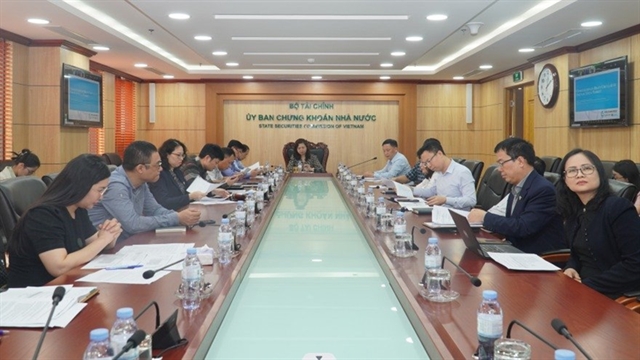 Society
Society

The revised Law on Child Protection, Care and Education will be voted on this Tuesday, during the ongoing final meeting of the 13th National Assembly. Much attention has been focused on raising the legal age of a child in Việt Nam from 16 to 18. Việt Nam News spoke to child specialists about this issue.
The revised Law on Child Protection, Care and Education will be voted on this Tuesday, during the ongoing final meeting of the 13th National Assembly. Much attention has been focused on raising the legal age of a child in Việt Nam from 16 to 18. Việt Nam News spoke to child specialists about this issue.
Youssouf Abdel-Jelil, UNICEF Representative to Việt Nam
A child is any person under 18 years of age. This is the definition given by the International Convention on the Rights of the Child (CRC). It’s also the definition agreed by all but a handful of States in the world. Việt Nam is a pioneer globally in upholding child rights. Vietnamese global leadership on child rights was reaffirmed with Directive No 20, issued by the Politburo of the Central Committee in 2012, which strengthened care, education, and protection of children.
Using 18 as the age to define a child does not mean that 18 must be legislated as the age for all matters relating to children. Recognizing that children develop and grow over time, national laws can set different ages at which children are considered capable of making decisions or taking part in certain activities. For example, national laws may say that a child is able to drive a motorbike at the age of 16, is considered criminally responsible at the age of 14, and can engage in light work at the age of 15. However, in recognition that they are not yet fully mature, all children under the age of 18 are entitled to special care and protection. Both parents and the Government continue to owe a special duty to children until they reach adulthood.
By defining a child as one under 18 years old, Việt Nam can extend protection of rights to cover all children, and avoid the risk that children aged 16-18 years fall through the gaps.
UNICEF is extremely concerned that failure to raise the age of children to 18 would have negative consequences for children, denying them support and protection at a critical time of their growth. Việt Nam is facing a defining moment in time. UNICEF trusts that Việt Nam will continue its pioneering status in protecting children and legally define everyone under 18 as a child, in conformity with international child rights standards.
Đặng Hoa Nam, director of the Child Care and Protection Department, under the Ministry of Labour, Invalids and Social Affairs (MOLISA)
Raising the age of children from 16 to 18 is necessary. This will widen the range of children we can protect. Children are facing a lot of risks now, such as sexual abuse, unexpected pregnancy, abortion and early marriage. These are all urgent problems which need more attention and management by society. At present, most of the child welfare policies on care, protection and education protect children under 16 years old. Few child welfare policies protect 17- and 18-year-olds, who need lots of care related to reproductive health, psychological health, and career counseling. Raising the legal age of children to age 18 means that more children will benefit from child welfare policies.
International scientific and legal research shows that ages 17 through 18 is a very important period which decides adult decision-making capacity afterwards.
Raising the legal age of children to 18 years old will also ensure the suitability of the Law on Children and the present system of laws protecting adolescents. Legally defining children as those up to 18 years old will not create obstacles concerning the rights and responsibilities of those under-18-years-old, with regard to other laws and regulations, such as the Civil Code, the Penal Code and the Law on Labour.
Raising the legal age of children to 18 expresses the country’s commitment to the international community during this period of integration and development. The United Nations’ Committee on the Rights of the Child has encouraged Việt Nam to raise the legal age of children to 18 years old so as to be in accord with the Convention of the Rights of the Child, which the country ratified 25 years ago.
MOLISA conducted a survey on the amended Law on Child Care and Protection. More than 34,500 teenagers from 63 cities and provinces participated in the survey. 53.5 percent of respondents agreed with raising the legal age of children to 18 years old.
Đào Trọng Thi, head of the National Assembly’s Committee for Culture, Education, Youth, Adolescents and Children
Việt Nam’s Constitution and related laws specify that only those over-18-years-old have full citizens’ rights and responsibilities. So the country’s laws stipulate that those under-18-years-old are not adults. So 18 is the boundary between adolescents and adults.
Scientifically, 16- and 18-year-old people have not reached maturity and do not have fully developed physical atrributes, brain, psychology, social awareness and legal understanding. They do not have enough knowledge to be adults yet. So they need care, protection and guidance from family, school, community and the State to avoid coming to harm.
Raising the legal age of children will not affect any other regulations, such as the Law on Youth, Labour Law and the Communist Youth Union’s Regulations. This is because within the regulations, the definition of children and adult, youth and adolescent are variable factors. Specifically, the Labour Law has separate regulations for workers at the ages of 15 to 18, and different regulations for workers between the ages of 13 to 15. The Penal Code also has different punishments for violators between the ages of 14 to 18 years old, and those older receive stricter punishments.
So raising the legal age defining young people as children will not put any pressure on the State budget, either. All of the State budget for children will be gradually adjusted at different stages, to accomodate changing variables. — VNS









.jpg)